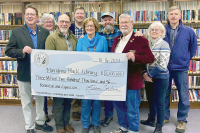The allure of falling water
Although most people are drawn to waterfalls, many pause before they can articulate why. For some, it’s the sound of the water tumbling over the rocks. For others, it’s the sheer beauty or tranquility.
“Everybody loves them, but nobody can tell you why,” said Kevin Adams, author of North Carolina Waterfalls, A Hiking and Photography Guide. “We’re just mesmerized by them.”
• View the interactive map of 50 selected waterfalls in WNC
• See also: A few wrong turns on the way to paradise
Part of Adams’ love for waterfalls stems from his passion for photography.
Sometimes he’ll take ladders and ropes or swim with his camera to get the shot he wants. But he’s careful and has never hurt himself at a waterfall.
“I respect them. I know how dangerous they are,” Adams said. “I have a wife I love very much that I want to come home to.”
For a quarter of a century, Adams had been trying to shoot a picture of a moonbow, a rainbow caused by the light of the moon instead of the sun. And last winter, he got the shot after standing for 45 minutes in the freezing spray of Rainbow Falls on the Horsepasture River.
Related Items
With eight inches of snow on the ground and temperatures dipping to 15 degrees, Adams’ camera, clothes and tripod were covered with a thin layer of ice. But he didn’t notice — not until he started heading back to his car.
Whatever the power of attraction may be, the Jackson County Travel and Tourism Authority knows the ability waterfalls have to draw visitors to the area.
“We understand that waterfalls are one of our greatest resources and attractions,” said Julie Spiro, tourism director in Jackson County.
Spiro has capitalized on being at the heart of waterfall country by creating a map of 19 waterfalls in or near Jackson County. They go through 50,000 of the brochures every year.
“We hand them out all the time,” Spiro said. “It is the most popular product we put out. It’s a wonderful relaxing thing to do that’s still free.”
Spiro has been to all the waterfalls on the map so she can give accurate instructions to visitors. If a tourist can only see one waterfall, she recommends Whitewater Falls, which at 411 feet is the highest waterfall on the East Coast.
“This is the one that will make the biggest impact on their memory,” she said.
Adams also has had great success with his guidebook and photography, so much so that he was able to quit his carpentry job about five years ago and follow his passion fulltime.
His parents always talked about writing a guidebook on North Carolina waterfalls after seeing Lineville, Whitewater and Looking Glass falls on vacation. But it wasn’t until the early 1990s that Adams took on the task.
In 1992, Adams made a cold call to the John F. Blair publishing house in Winston-Salem to see if the guidebook was a feasible idea. He got an answer he wasn’t expecting.
The publisher just happened to be looking for someone to write a book on waterfalls and invited Adams in for an interview. He landed the job. It took Adams a year to do the research and six months to write before the book went to press in 1994.
The waterfall gurus
Adams has seen more than 800 waterfalls — likely more than anyone else alive. But he remains humble about his expertise and willing to share his knowledge. When someone calls him a “guru” or refers to his book as a “waterfall Bible,” he chuckles.
“I realize I know more about North Carolina waterfalls than anyone else on the planet, but I don’t think of it that way,” he said. “Nobody will ever come close to seeing all of them.”
Like Adams, visiting waterfalls is a part of both Jordan Mitchell’s family heritage and publishing success. But Mitchell has gone the online route, posting his information about waterfalls online at northcarolinawaterfalls.info.
The website draws 150,000 unique visitors every month during the summer.
“I have this dueling interest between the outdoors and computers,” he said. “This allows them to come together.”
Between his fulltime job as a software developer and as a new father, Mitchell only makes it to waterfalls a few times a month — still more than most people do in a year, but not enough by Mitchell’s standards.
His daughter, Harper, was only 5 months old when he took her to her first waterfall — also one of the first waterfalls he had ever been to, Douglas Falls in Buncombe County. At the base of the falls, the chronically fussy baby simply stared at the water in silence.
“She was more thrilled than I could imagine she’d be,” he said. “She was mesmerized.”
Why the rush?
Bryson City writer and naturalist George Ellison said he thinks part of the reason people are fascinated with waterfalls is that they activate all five senses, likening the experience of standing at the base of a waterfall to walking into a bakery.
But there may be an even stronger scientific reason behind people’s fascination with waterfalls and for the euphoric feeling many have at the base of a waterfall.
Rushing water in waterfalls releases negatively charged ions. Once they’re breathed in and begin to circulate in the blood, negative ions trigger biochemical reactions that increase the production of a neurotransmitter called serotonin, which can reduce stress, lift the mood and increase energy, according to “Negative Ions Create Positive Vibes” written by WebMD reporter Denise Mann and reviewed by Dr. Brunilda Nazario. They also increase the amount of oxygen that gets to the brain.
“The air circulating in the mountains and the beach is said to contain tens of thousands of negative ions — much more than the average home or office building, which contains dozens or hundreds, and many register a flat zero,” Mann wrote.
But some scientists remain skeptical of the claim. And many waterfall goers feel the escape the scenery offers is enough to lift their spirits.
“I enjoy taking the day off from work and getting away from it all,” said Tom Mendenhall after hiking with his brother and friend to reach Wardens Falls in Panthertown earlier this month.
Wayne Joyce, Mendenhall’s friend with a vacation home in Cashiers, said he plans most of his hikes around waterfalls, often eating lunch at the base. Wardens Falls is one of his favorites.
“We hiked five miles to get here so we must like it,” he said.
That same day, Dawn Lavers came to Wardens Falls with her friends and family, who recently moved to Lake Toxaway from Florida.
“We only come when we really don’t have to be anywhere,” she said. “You don’t ever want to be rushed to leave.”
Lavers said that there’s beauty in every waterfall, but that each one is beautiful for a different reason. Some are powerful and dangerous; whereas, others are tranquil and secluded or make for great swimming holes.
The beauty of the region’s waterfalls was enough to lure Rich Stevenson, founder and developer of ncwaterfalls.com, to move to the mountains from Raleigh.
While he was working at Federal Express, Stevenson visited friends in the mountains who took him on a tour of the chain of falls on the Horsepasture River, including Turtleback and Rainbow Falls.
“I used to be a big beach person, but after that I kept coming back to the mountains,” he said.
Stevenson quit the two jobs he had in the Triangle and moved to Western North Carolina. Since then, he estimates he’s seen 400 to 500 falls. Some of the falls he heard about from locals he worked with at his manufacturing job in Candler — locals who’ve spent their entire lives exploring and fly-fishing in the backcountry.
“Once they realize I wasn’t a city wacko, they’ve turned me on to some places,” he said.
In 1999, Stevenson began posting his waterfall finds online. And in 2001, he launched ncwaterfalls.com, one of the most comprehensive online indexes of North Carolina waterfalls.
“At first I thought I was the only fool out there looking for waterfalls,” Stevenson said.
But Stevenson was wrong. The site has grown to include about 280 waterfalls and receives between 1,000 and 2,000 unique visitors a day.
Waterfall hunters
Stevenson soon learned there was a circle of waterfall hunters like himself, those who will strike out along a creek coursing over steep terrain, sometimes bushwhacking and sometimes wading their way down the mountain hoping to discover a previously unknown waterfall.
Stevenson’s swing shift job keeps him from exploring new falls as often as he’d like. Usually, his friend Bernie Boyer, a retired man in his seventies, will study topographic maps, discover a new falls and take Stevenson to it on his next trip.
But sometimes Stevenson finds time to hop in a creek bed and head upstream in hopes of discovering something himself.
“Usually the first thing is that you hear the sound,” he said. “You feel your heart pounding a little bit. There’s a real excitement knowing there’s something around the corner.”
But when it comes to the relatively undiscovered falls, Stevenson and Adams use discretion before making directions available to the public.
Although some of sights they discover are spectacular, the environment at the base of the falls is fragile, covered in rare plant and animal species. A plethora of hikers would destroy the falls’ unique inhabitants.
“You go there and you see that it looks like nobody’s been there for 100 years,” Stevenson said.
Some of the most unique species located at waterfalls are rare ferns, typically found only in the tropics. Because these species of ferns in North Carolina don’t grow to their adult form, they don’t look like a typical fern. They are usually only a small leaf.
The species grow in low light and moist, cool environments, the conditions found behind a waterfall.
“You have a small area with a lot of diversity in a microclimate,” said Anya E. Hinkle, Highlands Biological Station associate director. “Even if it’s hot, a waterfall really cools things off quickly.”
Figuring out how the species took root at North Carolina waterfalls can solve mysteries related to plant migration or provide geographical clues about how the areas were once located closer together before the continents shifted to their present positions.
Naturalist George Ellison often leads flora tours to waterfalls to view the unique plants. He’s seen many of the area’s falls, but some of his fondest memories come from Little Creek Falls, a small-flow, nearly vertical cascade in a lesser known area of the Great Smoky National Park outside Bryson City.
He would take his children to the falls decades ago before the public property in front park entrance came under the ownership of a trout farm.
“People are naturally attracted to the larger ones like Whitewater Falls,” Ellison said. “But those aren’t the ones that mean the most to people around here.”
It’s one of those smaller waterfalls that Kevin Adams holds a particular fondness for. Although he doesn’t usually name the falls he discovers, he named one in the Nantahala National Forest Loretta Falls after his mom.
“She instilled the love of waterfalls in me,” he said. “I knew she would absolutely love it.”
The falls is the tall freefall of a small creek. At the base of the falls, there’s no pool, only thick moss and ferns and some tall hemlock trees.
“It’s a really nice feeling to walk up to a waterfall that you’ve never seen before,” Adams said. “I got to tell you that’s one hell of a feeling, standing there in front of it.”









